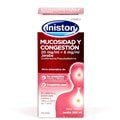Iniston Mucus & Congestion 20 Mg/Ml + 6 Mg/Ml Syrup 200 Ml
It is indicated in adults and children from 7 years of age to relieve productive cough by reducing mucus and phlegm in colds and flu accompanied by nasal congestion.
It is indicated in adults and children from 7 years of age to relieve productive cough by reducing mucus and phlegm in colds and flu accompanied by nasal congestion.
Iniston Mucus and Congestion (20 Mg / Ml + 6 Mg / Ml Syrup 1 Bottle 200 Ml)
Guaifenesin / Pseudoephedrine
ACTION AND MECHANISM
- [EXPECTORANT], [NASUS / PHARYNX DECONGESTANT]. Combination of an expectorant together with an alpha-adrenergic receptor agonist sympathomimetic agent, which produces a decongestant effect on the nasal mucosa.
INDICATIONS
- Facilitate the expulsion of excess mucus and phlegm in [COMMON COLD] and [FLU] accompanied by [NASAL CONGESTION] in children from 7 to 12 years old.
POSOLOGY
- Kids:
* Children from 7 to 12 years (approximate weight between 21.5 kg and 43 kg): 5 ml / 8 hours.
* Children under 7 years: Contraindicated use.
RULES FOR CORRECT ADMINISTRATION
Drink plenty of water during the treatment. Drink a glass of water after each dose. Wash the teaspoon after each feeding.
If the drug is administered at night, it should be taken a few hours before bedtime, to minimize the possibility of insomnia, especially in patients with difficulty sleeping.
Administration with food: take this medicine with meals
CONTRAINDICATIONS
- Hypersensitivity to any component of the drug.
- [PORFIRIA]. Acute attacks of porphyria could occur.
- Severe heart disease or uncontrolled diabetes mellitus.
- Patients in treatment with antidepressants of the MAOI type in the 14 days before starting therapy with pseudoephedrine (See Interactions).
PRECAUTIONS
- History of [KIDNEY CALCULATIONS], since guaifenesin could stimulate its formation.
- Patients in whom sympathetic stimulation could worsen their pathologies, such as those with [DIABETES], [GLAUCOMA], [CORONARY INSUFFICIENCY], [ISCHEMIC CARDIOPATIA], [CARDIAC ARRHYTHMIA], [ARTERIAL HYPERTENSION], [HYPERTHROIDISM] PHEOCHROMOCYTOMA] or [PROSTATIC HYPERPLASIA]. In severe cases, it may be advisable to avoid the administration of pseudoephedrine (See Contraindications).
- Chronic cough. If after seven days the cough does not improve, it is advisable to consult a doctor.
PRECAUTIONS RELATING TO EXCIPIENTS
- This medicine contains tartrazine as an excipient. May cause allergic-type reactions including [ASTHMA], especially in patients with [SALICYLATE ALLERGY].
- This medicine contains yellow orange S as an excipient. May cause allergic-type reactions including [ASTHMA], especially in patients with [SALICYLATE ALLERGY].
- This medicine contains sucrose. Patients with hereditary [FRUCTOSE INTOLERANCE], glucose or galactose malabsorption, or sucrase-isomaltase insufficiency should not take this medicine.
- This medicine contains sucrose. Its use in oral liquids and pharmaceutical forms that remain in contact with the mouth for a while can damage the teeth.
INTERACTIONS
- Antihypertensives (beta-blockers, diuretics, guanethidine, methyl-dopa). Pseudoephedrine could antagonize the antihypertensive effects, and even lead to hypertensive crisis, so it is recommended to monitor blood pressure.
- Digoxin. The risk of cardiac arrhythmias associated with phenylephrine could be increased.
- Nerve stimulants (amphetamines, cocaine, xanthines). Nerve stimulation could be enhanced, leading to intense excitability.
- Thyroid hormones. There could be a potentiation of the effects of both drugs, with a risk of arterial hypertension and coronary insufficiency.
- MAOI. MAOIs could potentiate the effects of pseudoephedrine by inhibiting its metabolism, increasing the risk of hypertensive crisis and other cardiac events. It is recommended to avoid the administration of this medicine in patients treated with MAOIs in the previous 14 days.
- Levodopa. The administration of levodopa together with sympathomimetics increases the risk of cardiac arrhythmias, so a decrease in the dose of the adrenergic agonist might be necessary.
- Nitrates. Pseudoephedrine could antagonize the antianginal effects of nitrates, so it is recommended to avoid the association.
- Sympathomimetics, such as nasal decongestants, appetite suppressants or psychostimulants. Adverse effects such as nerve stimulation and tachycardia could be potentiated.
PREGNANCY
The safety and efficacy of this medicine during pregnancy have not been evaluated, so it is recommended to avoid its use, unless the benefits outweigh the possible risks.
LACTATION
It is unknown whether guaifenesin is excreted in milk, but pseudoephedrine does so in small amounts. It is therefore recommended to suspend breastfeeding or avoid the administration of this medicine.
ADVERSE REACTIONS
Adverse reactions to this medicine are rare and usually mild. They have been described:
- Neurological / psychological. [EXCITABILITY] with [NERVIOSISM] and [INSOMNIA]. Very rarely [HALLUCINATIONS] may appear.
- Cardiovascular. [PALPITATIONS], [TACHYCARDIA], [ARTERIAL HYPERTENSION].
- Allergic / dermatological. [EXANTEMATIC ERUPTIONS].
ADVERSE REACTIONS RELATING TO EXCIPIENTS
- Because it contains propyl parahydroxybenzoate, it can cause [HYPERSENSITIVITY REACTIONS] (possibly delayed).
- Because it contains tartrazine (E-102), it can cause [HYPERSENSITIVITY REACTIONS].
- Because it contains yellow-orange (E-110) it may cause [HYPERSENSITIVITY REACTIONS].
- Because it contains methyl parahydroxybenzoate, it can cause [HYPERSENSITIVITY REACTIONS] (possibly delayed).
OVERDOSE
Symptoms: Overdose can lead in most cases to mild nervous excitement, characterized by the presence of anxiety and seizures, and cardiovascular involvement, with tachycardia and high blood pressure. Mild gastrointestinal symptoms, such as nausea and vomiting, and difficulty urinating, have also been described.
Treatment: In case of overdose, the usual elimination measures will be used. It is recommended to administer an emetic and perform a gastric lavage if less than two hours have elapsed since ingestion. Active charcoal is only effective in the first hour of poisoning. If more time has passed, a urinary acidifier can be administered to promote the elimination of pseudoephedrine. In case of urinary retention, the bladder will be catheterized.
Doping
Pseudoephedrine is a prohibited substance during competition.
It is prohibited when its administration results in a urine concentration greater than 150 mcg / ml.
The detection in a sample during the competition of any quantity of pseudoephedrine in combination with a diuretic or a masking agent, will be considered an adverse analytical result, unless the athlete has obtained an approved therapeutic use authorization (TUE) for ephedrine, in addition than that granted for the diuretic or masking agent.
It is considered a “specific substance” and, therefore, a violation of the rule in which this substance is involved may cause a reduction in the penalty as long as the athlete can demonstrate that the use of the specific substance in question was not with the intention of increase your athletic performance.
Iniston Prospectus Mucus and Congestion 20 Mg / Ml + 6 Mg / Ml Syrup 200 Ml



